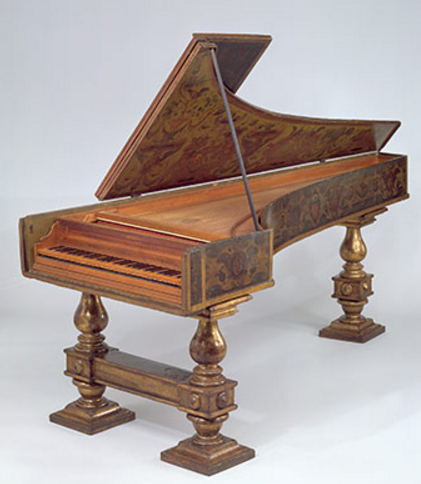~ Silent Architecture of Pitches de Musica ~ 'if it sounds good ... it is good'
|
|||||||||||||||||||||||||||||||||||||
"If it sounds good it is good." Attributed to America's own maestro, composer and piano master Duke Ellington, his quip sparks to life here the basis of our understanding of all our musics; for when we follows nature's own original way of creating and organizing the pitches together, they sound pretty darn good. We love the songbirds yes ? And it just turns out that we musicians use a lot of the same pitches, imagine that :) |
|
So with a tuning tweak here, a tweak there and there, and then a tweak right there, to the earthly natural songbird pitches, we can know the historical steps and understand the evolution of the science behind the tweaking. For it was understanding deeper into the calcs of the same numbers; 1 2 3 4 5 etc., brought from the lands of Eastern Asia to Western Europe and then to New World America, that enabled each of the 12 tuned pitches to become equal partners in creating the joyous Americana weave of songs of waybac and today. So all the way back in history to the triangle geometry studies and toga days of Pythagoras and forward with the same golden rule of our musics; 'if it sounds good, it is good', as our basis. |
Nutshell ~ 'silent architecture' of our pitches. In all of our musics today, there is an architecture to organize the pitches that is based on what sounds good, is pleasing to the ears. From Mother Nature we inherit our pitches and this 'silent architecture' structure of their organization. Within this framework is a 'series of pitches', that follows a consistent, measurable pattern each time sounded. And in this pattern lies the core of the architecture of building up our musical components. That our earliest theory brethren used this pattern, logic and measurable mathematics to create the 12 pitches we still use today is the topic at hand. |
While our more naturally tuned 12 pitches have always been capable of creating melodies, and even arpeggios, stacking them into chords was a challenge. We solved this tuning riddle, and built them into a piano only fairly recently, give or take, about 300 years past. Yet once this new tuning took hold, providing its full range of harmony, we've never really looked back. Here's a melody, arpeggio, chords and bass notes of our modern tuned up pitches of today. Example 1. |
With today's tuning, our musics have an upper melody line of single notes, supported or not, by stacked pitches of chords, which have a bass note. The single notes of the bass line create a story too, the melody to support the chord progression. All combined, its solid. This has been our way of composing most songs ever since. |
We today, inherit these tuned 12 pitches, all their scales, arpeggios and chords. They are all tuned up to sound good in any combination. We can draw from all of the 12 major and 12 minor tonal centers they create. In addition, we still 'find' the magic of the older pitches with ease, and in the Americana musics, we generally call them our 'blue notes.' Combined, tuned up pitches and blue notes, we've the pitches to create the full spectrum of our Amer ~ Afro ~ Euro~ Latin musics. |
Placing the pitches within the structures of musical forms, and motored by time concepts, all combine to create the 'silent architecture' of our Amer ~ Afro ~ Latin ~ Euro music. And with the guitar's unique ongoing capability of bend-able, string pitch melody notes and precisely tuned chords, through all the key centers, it all makes for a very remarkable instrument. Among the most popular instrument globally. |
Pop quiz. So in theory, how many pitches we got? ________. ( 12 right? Why essential? Well in theory, it's all we get :) |
Mother Nature's way. Let's examine Mother Nature's pitches, in the order they are created from one fundamental pitch, creating the overtone / harmonic series. This series of pitches believe it or not is what might hear when the wind whips over rocks, it's also created in the sustain note when we ring a bell, or ting a triangle, listen to the surf inside a conch, maybe even in the roar of a lion if we get to close :) Example 1a. |
|
Hear any logic in the sound ... ? Maybe an arpeggio or chord ... it's in there. Can we 'build' these pitches into a musical instrument ? |
Our earliest musical pitches ... a fable of sorts. A fairly recent discovery of an old flute by archeologists gives us a possible glimpse of the pitches of days long long past. The news flash story goes like this. A piece of an old flute was found in a giant cave deep in Slovenia, so Eastern Europe. Using computers, the finders reconstructed this ancient fragment into a modern facsimile of the original. When placed in masterly musician hands, this flute created pitches startlingly similar to our own today, if not with a bit of an eerie ancient quality, giving bit of the familiar melodies played, a true 'from another time' quality. |
Our 'silent architecture' discussion here today takes us nearly all the way back to our origins, on through the now ancient Mediterranean toga era of the Greeks, and into the new world of the Americas, where our two core tuning systems melted right on into one; which is the one we have used all along now and still use today. Surely a long road of history here but even the longest journey needs a first step right ? |
Tuning tweaks. Even though our story includes thousands of years of creative output, creating the rich and varied collection of global musics we enjoy today, the silent architectural structuring of our pitches has stayed close to its origins. Founded on earthly natural sounds, and as we'll soon see, scientifically measurable as physical acoustical properties, we've simply tweaked our tuning of this natural architectural core a time or two over the millennia, to arrive at today's pitch resource for the modern artist, the need driven by the artists as they hone their elements to create art. |
As guitarists. Turns out all we need to begin this discovery is already built right into our instruments. We're simply going to follow the way we think it was originally done. To use the pitches created by the guitar's natural string harmonics to recreate the original process. Been up around the 12th fret lately ? :) |
|
Our story begins at the village blacksmith's shop and with the perfect octave interval. Core aspects of our present day organization of music comes to us as part of a package deal, often described under the broad heading of Western Civilization. We can trace this thread back through European history to the Romans and even further back through to the Greeks circa 1500 B.C.E., whose philosopher Pythagoras, ( pictured above ) who lived around 500 B.C.E. era or so, is credited to have discovered the organic, natural basis of our 12 pitches and interpret and represent them in true numerical values, using the math he and his mates mostly invented. That Pythagoras solved the triangles creds his music too. |
|
Go figure :) As our written historical attests, while Pythagoras and his band were passing by their local hardworking blacksmith shop, hearing the simultaneous clanging of hammers and its raucous racket, legend has it that within this cacophony of noise, someone recognized that certain, repeatable combinations of the hammer blows created sonorous or pleasing combinations of pitches ... while other hammer blows did not. |
|
A pioneering heavy metal enthusiast no doubt, Pythagoras' further inquiries of the hammering craftsman revealed that these most agreeable combinations of sounds were created by hammers whose physical weights were somehow in measurably even proportions ( ratios ) to one another; one half the size of another etc. |
This discovery of the relationship between physical proportion and pleasing sound apparently excited curiosity, prompting Pythagoras and his peers to further research, and to measure the nature of physical sound and its effects on our human psyche and aural sensibilities. |
Recreating the magic. Devising a single stringed instrument called a monochord, Pythagoras is thought to have discovered and recorded in writing, though now lost to us, the beginnings of our understanding as to the physical, measurable relationships of why two different select pitches sound good when played together. This monochord, as pictured below, again shows the man himself with his rig at work. Looks like a six string axe, two bridges and string tension weights for tuning the strings to different pitches? Matched grip on the sticks for setting the thing all in motion. Example 1. |
|
|
|
Concordant tones. 'So ... if it sounds good, it is good' ... from our own 'Duke' of course holds true. For it is these pioneering discoveries of the natural properties of pleasing combinations of pitches, what became know to us as concordant tones, which forms the theoretical basis, the silent architecture of our musics. |
|
The octave (two notes) purity of sound. Sounding a fundamental pitch and coaxing forth its various harmonics, Pythagoras must have believed enough in the octave's purity of sound to make it the basis of his work. He and his pals might have also inherited this octave basis from their peers. Hard to say for sure, for here, the mists of antiquity become a thicker fog of uncertainty for today's active musicologist. It'll also turn out that the aural purity of the octave can be represented by the simplest ratio of whole numbers. This 'whole numbers mathematics' fiercely governed the tuning of our our pitches for a couple of millennia. Thus; naturally pure and simple combinations of pitches and numbers fed the ancient music theory bulldog. |
Click the following music for mp3 playback and sing along, finding the octave interval of C natural, written in today's standard notation with the 'G' treble clef. Are you cool with the notation symbols? Of course the tab helps too in locating pitches for guitar. If needed, try the link to explore the nuts and bolts of notation and a bit of its history. Example 2. |
Can you confidently sing a strong and in tune octave interval? A big first leap for sure but a challenge worthy to master. Maybe learning a stronger melody that includes and octave interval will help lock in the pitches. |
The perfect octave interval is the core. We theorists determine this purity of our intervals by how completely two pitches aurally blend together. Turns out that the less we can distinctly hear either of the pitches of the interval, when sounded together, the greater purity the interval is said to be. Thus, less truly is greater :) Perfection of sound becomes the ... complete merging of two pitches into one ... |
That we only get three perfect intervals out of all the many, many possible pitch combinations in our system, is testament to their natural powers from Mother Nature. Their individual tonal strength and balance triangulates a three part silent architecture for our musics. Hipsters will already know these three pitches as the root notes of the '1 4 5' chord progression. |
For when the octave interval is sounded, the two pitches melt together and we mostly hear just one pitch overall, created by the two different pitches combined; a hint of the upper tone and hint of the lower become one tone. With musical notes from our instruments, we are simply re-creating the pure physical phenomena of earthly natural acoustics. Do click over to examine Mother Nature's pitches, in the order the pitches are created from one fundamental pitch, creating the overtone / harmonic series. |
Perfect closure. So perhaps no real surprises here, but this first idea and principle now solves the initial theory puzzle; that of creating a perfect closure, thus a looping of the pitches. The two pitches of the octave interval are the bookend pitches of our perfect, unbreakable loop of pitches. For everything we ever might theorize by pitch letter name or by their number representation even, wherever we start, we'll return to our start point. Our closing pitch might be an octave or two up, or down, but carry any sort of theory sequencing on long enough, and we will return to our start point. If we don't, we'll know there's something amiss in our calculations or, we've discovered something brand new. |
Sound the following octave interval a couple of times and hear the melding of the two pitches into one. Octave purity a la midi digital, the purest of our musical intervals when accurately tuned. Example 3. |
Do you hear what I hear? As the octave interval is sounded, does either the upper or lower pitch stand out? Hear any hint of the upper or lower pitch stand out in their combined sound? Try it again. A magic merging of the two pitches or Mother Nature's perfection ... ? :) |
Hear the lower pitch first and then the upper as its sound tails off? No ? Me neither. Yet, in the ringing of church bells, we might hear the fundamental pitch i.e., the lower pitch, and then the higher partials above when an octave interval is sounded as the 'peel' fades off. |
An experiment. Try sounding the octave interval on a tuned up instrument such as piano or guitar. Play the lower pitch then upper. Reverse and try again, sound the pitches together. Listen for 'one pitch combined', which tells us our octave interval is tuned up. For even slightly out of tune octaves brings the waves. That 'wa wa wa' we hear when one note is not quite tuned up as the two octave pitches are sounded together. Waves / oscillations. Science termed as 'beats' and 'cycles per second', counting up the waves per second created by an untuned octave interval, tells us how far off we are from our goal of a 'perfect octave unison.' When these 'beats' stop between our octave pitches, we know they are in tune. |
Listen for the beats. Click to sound the following example, comparing the most common of our intervals on our palettes. Listen for the purity of 'melting tones' when the octave interval is sounded. Example 4. |
 |
Cool? Of all of the tasking with the theory, hearing it in action is typically the longest row to hoe. Luckily, once these things begin to fall into place for us, they build rather quickly and once we got it, we keep it forever :) |
Quick review. It's this naturally occurring, purest marriage of the two pitches into one sound, that forms the initial and permanent core and basis of our local theoretical musical universe. We theorists use this octave perfection as our standard for defining the sound quality of all of our other musical intervals. And for a very long time now we've termed the octave, and its soon here to be discovered closest relatives, our perfect intervals. This theory basis of the pitches has been around for about 2500 years now and is the silent architecture of our own Americana pitches. |
"Simplicity is the ultimate sophistication." |
wiki ~ Leonardo da Vinci |
Simple is best. As we'll aurally hear and theoretically formulate as we progress in our study, none of the other musical intervals we have on our 12 note color palette can match the sound of the octave, not only perfection of aural blending but as it turns out, in its mathematical simplicity as well. Ah yes ... music and math :) |
|
Guitarist Wes Montgomery. In thinking about the central powers of the octave interval, and its place at the historical center of our local universe, I'd be remiss not to speak of how jazz guitar legend Wes Montgomery spoke his melody pitches with octave doubling. While by no means alone in this art approach to melody and soloing, most Americana musicologists could agree that Mr. Montgomery changed the melodic arts forevermore with his own phrasing style in octaves, becoming an artistic signature known globally in modern today. |
|
That the depth of swing capable with octaves could very well succeed that of single note lines. Octaves swing deeply in traditional Americana styles from folk to jazz and love the blues too. For us guitarists, Montgomery's ideas are surely as revolutionary in style and impact to his contemporaries and forward as Louis Armstrong had done for trumpet in the 1920's. |
|
the octave / 2:1 |
Music theory and physical science. Like most sounds we hear, we can define our musical pitches as physical vibrations of air waves and as such, we can measure them a couple of ways. |
Recreating Pythagoras' monochord, we can physically measure with any sort of ruler the length of an open string on our guitars. This we term our scale length, it generates our fundamental pitch. We then locate where the octave above harmonic lives and physically measure its length and compare the two. |
Even though this next diagram is not to scale, any guesses as to where we will find the octave harmonic? Find a guitar, or any string instrument, and a ruler to try this. Hint; look for the double dots on the edge of the fret board. Example 5. |
24 inch string length /_____________________________________________/ 12 inches octave 12 inches /______________________ / _____________________/
|
From the diagram we can see the location of the octave. Think of where those 'double dots' live on the edge of your fingerboard. We simply divide our string length perfectly in half, from bridge to nut, to locate the octave harmonic. Is this the harmonic we use in intonating our instruments? Yes indeed. Pythagoras was said to be first to represent this pure octave sound mathematically by a ratio of numbers. |
If we represent our entire string length by the number one (1), then split it into two equal parts (2), what would our ratio of numbers be in describing the relationship between the higher pitch (2) and lower pitch (1) ? |
Ratios of numbers describe the magic. The mathematical ratio of the two pitch octave interval turns out to be simply 2 to 1, both of which are said to be prime numbers. Expressed numerically with a colon symbol as 2:1, this ratio of numbers in music implies that the upper or higher pitch of the octave pairing vibrates twice for every one vibration of the lower pitch, thus the 2:1 numerical designation. |
In olden times, as the scientific perspective of physical nature evolved, they looked for these perfect numerical relationships to justify, order, catalogue and determine that all was groovy in their numerical representation of their physical universe. They simply were doing the best they could with what they had, in the emerging field of scientific measuring and discovery of the natural world. |
The expression of our musical intervals as ratios of numbers is important in another part of our historical story, one that in a sense reflects a thousand years of the European experience, during which time our natural sciences emerged. The gist of this story is that these prime numbers were used to help center the celestial, heavenly universe right here on earth, through music :) |
|
These ratios of prime numbers shaped not only the purity of the musical sounds but also various artistic proportions in fine art, architectural building, even in creating the day to day necessities and activities of life were, to a fairly consistent degree, governed and oftentimes dictated by the absolute purity of the prime numbers. So it just turns out that ... purity of sound = purity in numbers |
And while we won't really get to that story here, a good read for those curious about this historical relationship between pure numerical ratios, musical intervals, their tuning evolutions, really all things grand scheme coupled with the 1000 year ( give or take ) evolution of the various cultures of Western European society, would be a wonderfully told story in print by pianist and educator Dr. Stuart Isacoff titled; The Idea That Solved Music's Greatest Riddle. |
After 2 then 3 ... The next sequential step after a two part division of the octave would be to divide it by three. We again credit Pythagoras for creating this process, which in turn invents a wheel for creating our 12 pitches. For by dividing our string length in three equal parts, we create the second of our perfect intervals, what we often term the perfect 5th. |
Applying this to our guitar string, ( or a column of air ) we can create the harmonic above the 7th fret, which on most guitars will have a locator mark on the fingerboard and a dot on the edge of the neck. Do examine this next diagram illustrating the string division for the colossally important interval of a perfect 5th. Example 5a. |
24 inch string length /_____________________________________________/
12 inches octave ~ 2:1 12 inches /______________________ / _____________________/
8 inches perfect 5th ~ 3:2 8 inches /______________ / ______________ / _____________/
|
The math. The three part division of an entire string length creates the interval of a perfect 5th, our third partial above the fundamental pitch. Its vibrational sound ratio is represented numerically as 3:2, both of which are again prime numbers. |
When we hear this interval created by two strings vibrating together, the three to two ratio implies that the string of our upper pitch is vibrating three times for every two of our lower one. When we combine the two pitches we hear the sound of what we term a perfect fifth interval. |
Using the letter C to identify our fundamental pitch and key, examine how the interval of the 5th above C is notated and how these two pitches are located on the guitar. We can find the letter name of the perfect fifth by simply counting up through the five letters of the alphabet from C (#1) to the letter G (#5). Example 5b. |
|
|
||||||||||||
Example 5c. |
Perfect fifth. Cool with locating the organic source of the perfect fifth interval ? As our new system of tuning evolved in the 18th century, so much of its impetus was keyboard driven. For all the pitch buttons are laid right out, just begging to be plunked together. Please examine the diagram below of the keyboard manual and see how easily we can count the keys to get to our interval of a perfect fifth. Example 5d. |
 |
The two graphics just above, give us a couple of ways to locate our perfect fifth interval above the pitch C; by counting the letter names on our fingers, counting the lines and spaces of the staff, or by counting up five white keys of the keyboard. |
So in the key of C, and also in its relative key A minor, it's rather easy to find the letter named pitches. To project the perfect fifth interval from each of our other 11 pitches, the one's we've yet to discover here, we'll have to adjust some of the letter names with music notation symbols we often term an accidental, in this case the sharps (#) and flats (b). |
Easiest to read. These letter name adjustments, and what we term enharmonic equivalents, are simply all about finding the easiest way to write our music out so it can be read and performed by other musicians. Properly written down, notated music also benefits all in creating a hard copy for future generations to enjoy. |
Perhaps a best example of this 'easiest to read' might be the note C. Its enharmonic equivalent would be B sharp. It's just way easier for most mortals to recognize and read a written C than a B#. Example 5e. |
 |
Quick review. Just as with the octave interval, the interval of the fifth is termed 'perfect' due to its pure and consonant sound quality. We can also correlate pitch perfection by our modern science's ability to measure, that the purity of a musical interval's sound quality also corresponds to the simplicity of mathematical ratios between the vibrations of its two combined pitches. |
Purest musical tones are our perfect intervals, created by the simplest ratios of numbers. For those curious about the math, examine the ratios of our twelve intervals contained within the one octave span and explore deeper into the mathematics of sound from there. Lots more tech info is just clicks away. Look closely for your own favorite pitch combinations and see how their ratios fit in with the others. Perhaps consider building your own stomp box to understand signal path, pitch wavelength and the altering of it. |
Modern power chords. Those in the know surely know, that this interval of the perfect fifth is the essential component we use to build the 'root + 5th power chords' for many of today's guitarists. Creating much of the over driven, crunchy sounds of the rock, heavy metal and general all round shred guitar styles of the last 25 years or so, 'less and simple' in pitches surely can become way 'more' in electric driven powerchords. |
So, from our current rocking sounds of today all the way back as far as we can basically go in written down, recorded history, we've had our perfect fifth interval as an integral component of the structural basis of so much music we love. Crazy huh? |
Ten pitches to go. So now we have generated two different pitches, C and G, we still need 10 more to make our total of 12, the correct number of pitches that comprise the modern chromatic scale. To find these pitches, Pythagoras simply repeated the process just described; by finding the perfect fifth above each successive note and in the process, creates a succession of perfect fifth intervals, until we've a loop of pitches that closes upon our starting point. |
Fifth by fifth by fifth we create our 12 pitches. We started with the pitch C and found its fifth note G by dividing our string length in 3 equal parts. We find our next fifth by using the pitch G as our starting point or fundamental, then simply divide its string length into three equal parts, to locate its perfect 5th above. Counting through our musical alphabet we come to the letter name / pitch D. |
We then repeat this process with the pitch D as our fundamental pitch, divide the string length in three and locate its perfect 5th interval, which we identify by letter as the pitch A. Pythagoras is said to have continued in this fashion until this pitch cycle closes back upon its starting pitch C, these sequenced, ascending pitches encompassing 6 full perfect octaves. And that's it, fine. And for the hipsters in the crowd, notice how any group of five notes around the cycle creates the wonder kinder perfect Yin Yang balance five note pentatonic scale ... ? |
|
Please examine the following letter names of our 12 pitches sequenced by the interval of a perfect fifth, and then as written out on the grand staff. Example 6. |
|
Interesting huh? Of course we do not get this range of pitches on our six string guitars. Which is probably a good idea. Run some of these lower and upper tones through a Marshall 50 watt and 4/12 cab and all of your neighborhood critters just might be a howling' for more :) |
And on a piano? Why nothing less than our '88's.' Seven octave loop and perfect closure of the musical letters / pitches; A B C D E F G A. Example 6a. |
Cool. Go find any keyboard and fool around on it. Remember to look for the pattern in the black keys, the consistent 2 / 3, 2 / 3 etc., ascending or moving up in pitch. This pattern builds in the diatonic half steps for our relative 'C major / A minor' key center. |
And now for the bad news, there's a tuning glitch :( In Mother Nature's own natural ways of making our pitches, as Pythagoras closed his circle of pitches, the closing note was a fair bit sharp from his starting pitch, think around 25 cents. So, even to novice ears, noticeably sharp. Like a quarter tone 25 cents ? Yea. So no perfect pitch closure? Nope. No perfect closure, out of tune. And although it took a couple of thousand years to solve this riddle and 'smooth out' the tuning, to perfectly close this loop, in theory the stage was set way back then for developing the modern day, 12 pitch resource we fully enjoy today. |
|
For surely there was music in Pythagoras' day and in the generations before his times. Those pitches and the scales they formed, while also generated from nature and closed by the octave interval, worked just fine. And they still do today. Any non-chordal creating, single line instrument, is free of this burden. Play on ! For even after 40,000 years these naturally tuned pitches still fill dance floors. For not until we wanted to stack pitches into chords and change key centers through modulation, and have in-tune chords in all of those keys all of the time (starting around in the 1600's or so) did the push really come to shove between theorists to close this tuning loop, whatever it took, and tune up the pitches to enable harmony / chords to completely evolve. And all this so we could tune up a piano? Yep. For a piano has ALL the changes ... all in tune :) |
Our musical key clock of pitches. Today we often find these 12 fifths arranged in a clock like configuration we term our circle of fifths. Starting at the 12 o'clock position with the letter C, we can move clockwise to the right by perfect fifth ( C to G to D etc. ) |
|
Counterclockwise motion to the left creates the inverse interval of our perfect 5th, the perfect fourth ( C to F to 'Bb' etc. ) Just like with some many regular time clocks, we move 12 clicks before completing our circle and returning to our starting point, forming a perfectly closed, unbreakable loop of our 12 pitches. Example 6b. |
|
|
Clockwise fifths. Among the most important theory aspects of this clockwise motion surrounds the creation of our key centers. A 'key center' is at its core, simply a group of pitches that we use to write our songs. That a tune's in 'G' for instance, implies that the song is written in the key center of G major. |
Key cycle. With each click on the cycle, moving to the right, one pitch changes. In moving from 'C' to 'G' in letter name pitches we get; 1 1 1/2 1 1 1 1/2 C D E F G A B C becomes 1 1 1/2 1 1 1 1/2 G A B C D E F# G We pick up a new sharp with each click for a new key center. As each key evolves, our new sharped pitch is always the leading tone or 7th scale degree, the essential pitch of tonal gravity that creates motion to our key center pitch. B wants to gravitate up to C |
Picking up a sharp. Please examine the following musical idea that illustrates moving one click to the right on our cycle of 5th's. Here we move from C major to G major. Example 6c. |
Counterclockwise fourths. In reversing the motion above, we move counterclockwise by perfect 4th. In perfect 4th motions, we gain the flats as we now lower the leading tone to create each new successive key. Example 6d. |
Sharps and flats. So we use our accidentals to equally project similar intervals / scale formulas / chord voicings from each of our 12 pitches. In the above music we're looking at the major diatonic scale of course, whose whole step / half step interval formula was set in stone a very long time ago. |
So now with twelve pitches we have the resource to create our melodies. Obviously we do not always play in perfect 5th's and 4th's when creating our music. So what we theorists do is re-configure these 12 pitches in the tightest formats available, while preserving the integrity of each pitch. In doing this we create a core strand of our musical DNA, the first of which is just one of many of our unbreakable loops and cycles of these same 12 pitches. |
Silent architecture / the half step. In the above ideas we used the perfect 5th to find our pitches, and we can easily re-configure our 12 pitches by half step, creating the chromatic scale, all within the span of one octave. Please examine the letter pitches and their sound in the following examples. Note the enharmonic equivalents, double labeling of five of our 12 pitches in the letter names which follow. Example 7. |
|
 |
The backbone of our silent architecture. Sounding the above graphic, we create what we theorists call the chromatic scale, truly representing the theoretical pitch backbone of our silent architecture. Constructed with just the half step interval, today's equal temper tuned chromatic scale contains each of pitches of the natural harmonic series, as well as the pitches set forth by Pythagoras within the octave span. |
Examine our piano keyboard / location of the half steps. This next graphic, which depicts a segment of our piano keyboard, illustrates the theoretical core of a couple of thousand years of musical evolution. It contains all of our pitches highlighting the natural location of the half step intervals within the relative keys of 'C' major and 'A' minor. |
These natural half steps are between the pitches B to C and E to F. Locating them at the keyboard is easy as there is no black key between them. Example 8. |
 |
Set in stone. As we create any and all of our musical components, we must always remember these two permanent locations of the half step interval between these pitches. Full pianos may extend the keyboard to include all of the seven octaves plus but even so, the built into location of these two natural half steps are always the same. |
And while this chromatic grouping of pitches is rarely found in popular musical composition as a whole scale, every other possible combination of notes comes from this perfectly closed loop of pitches. Thus, all of our scales, arpeggios and chords, the tonal elements that we use to create all of the American styles, plus all of the European classical sounds, they ALL come from this grand daddy of 'em all ... the chromatic scale. Even the blue notes? Yep, even the blue notes. |
A chromatic melody. Her's a familiar melody (?) of a mostly chromatic quality, that we all might remember from way back. An old carnival melody by Julius Fucik, dig a lick of the main theme of "Entry Of The Gladiators." Example 9. |
|
Familiar? Cool. And while we rarely hear this type of chromatically constructed melody in the American song book, the basic theory of the above line, to chromatically enhance a mostly diatonic melody is something we can often hear in the music. |
Due to the overall brighter tempos, jazz players are the main kings of this chromatic enhancement type of treatment. Charlie Parker himself perhaps being the original King Of Chromatic. Our modern day gospel, R&B melismatic vocal style, surely a close and very beautiful second. But even a bluesy hint of a lick, slipped into a diatonic idea, in theory, qualifies as chromatically enhanced, while the concept of 'blues enhanced' probably more accurate. |
Thus all manner of hammer-ons, pull-off's, trills, bends, more bends, any motion by half step or even a wide vibrato are common ways to chromatically enhance our music. Then there's the slide, which can bring it all into one continuous spectrum of pitch. And yet, even just a chromatic tone or two puts a bit of slip into a melody line from any style ... to 'jazz it up' as we say :) |
Add the rhythm back into this equation and here again, Mr. Parker just might be the all time king of the chromatic / blues hue enhancements, in both the American swing styles of the 30's and then into his own style of bebop, of the 1940's and beyond. The combination of chromatics and rhythms creates a vast universe to explore. Figure a way to 'half step lead in' a 'chickity' boom lick. Chops can become the real decider in this. So from many angles, the idea of chromatic enhancement has been an interesting component in much of the American sounds we dig. |
The chromatic nature of our guitars. The following diagram simply spells out the letter names of the pitches for the first 12 frets of our six string guitars. We can see by the labeling of the pitches that each of the frets are half step increments. Thus the potential for some very rapid chromatic runs for those so inclined. In making this chart I alternated sharps and flats by string. For in theory, key center determines actual letter names of the pitches ... n'est-ce pas? Example 10. |
 |
Isn't that so ... an essential picture? Learning the letter names of the pitches is simply part of the learning music process. Perhaps a good place to start is in insuring that we know the letter names of what is presently under our fingers. Then as our understanding of the theory and our musical components evolve, so will our need to know more of the letter names. |
| Or we could just go right ahead and learn 'em all by rote, starting right now and take a giant step forward! As we each have our own best way of learning something, just apply it to learning the letter names of the pitches. Use the chart above as a model. My professor at college would often say to us ... 'Ya know, you only need to learn this stuff once ... and once you do, then well have it forever.' This can be true with many things in life. |
The chromatic nature of the piano. The following illustration simply spells out the letter names of the pitches for the piano keys. Rote learn all of this you can, as quickly as you can. Like asap ? :) Example 10a. |
 |
Learning the half step interval. In the following musical example, the ascending 'C' major scale is followed by a descending 'C' chromatic scale. Click the music and sing along with the pitches. It's a bit tricky to do at first but keep trying and you'll get it. We train our ears to hear the pitches and simply sing along, over and over till we got it. Luckily, in doing this work, we also bring the music closer into our hearts. Example 11. |
 |
Interesting challenge yes? Eventually we want to chromatically sing the pitches a cappella. A solid part of the American musical magic is based on an artist's ability to 'sing the line ... play the line.' That magical connect helping the stories in our hearts become musical sound in motion through time. |
Silent architecture / musical style / art philosophy. Can we correlate just how many of these 12 pitches we usually find in melody with our own musical styles? Turns out there's a nice solid, pitch by pitch evolution to the 'groups of pitches' for creating melodies. And while there are endless variations and cross pollination between styles, this basic correlation of ... number of melody pitches and style ... creates a consistent way forward to investigate all sorts of musical topics; time, the diatonic realm, the scales ~ arpeggios ~ chords twist. The number of measures in a song's form will hint to a style, we've the 12 bar blues of course, and expanded song forms to explore, and the five pitch pentatonic cycle within Americana improv. |
The seven steps, a sequenced study of the basics. The links below form a curriculum for the very basics of understanding our musics that apply to all of our combined Amer ~ Afro ~ Euro ~ Latin musical styles. Take each in turn, rote learn their basics and take the vocabulary quiz to seal the deal. got a hill to climb ? ... ah, at the core of it all ... :)
|
Advanced theorist. Try any links to the right that rouse curiosities. |
Review. So from our existing written records, we discover that our musical pitches of today finds part of its theoretical origins with the Ancient Greeks. At its intellectual core is the ideal of aural purity, as based on the natural properties of physical sound, and how we as humans with our ears perceive it. |
Composed of a system of theory and tuning that divides the octave interval into 12 distinct, independent and equally functioning pitches, this pitch resource provides the artistic core from which we create all of the American and European musical styles. |
In more recent times, since the 1700's or so, this pitch resource is tuned or tempered equally, a tuning system we simply call equal tempered tuning. This method of tuning was created for the piano and has been there ever since. This looping perfection of pitch, which allows for the 'in tune' art of sequencing and ideas, together combine to define essential compositional elements. |
How and why we reached this perfection. While earlier tuning systems worked fine for the music comprised of one or more melodic lines we today term polyphony, it was in the evolution of the vertically stacked pitches of harmony, played on keyboard instruments, that we see a greater need to accept the equal temper system of tuning. For while there was a certain degree of 'stackability' to the pitches tuned the old way, it was said to be limited and unstandardized, thus holding back the musical directions then being explored by composers, all music was once new. |
This tuning development encouraged composers to venture further a field with key schemes and modulations. As guitarists, we have a record of 16th century lutenist Vincenzo Galilei, father of famed astronomer Galileo, using the 'rule of 18' in the 1550's to position the fixed frets on his lute to create an equal temper pitches, thus a fully functioning chromatic, melody and chord capable stringed instrument. Like today's banjos, mandos, guitars, basses et all ? Yep. |
|
What the future may hold. Furthermore, as equal tempered tuning itself evolved to further stabilize our natural acoustics and earlier systems of tonal organization, perhaps it will also provide the structural basis for a new, musical system of tomorrow. The electronic computerized MIDI systems are just such creative directions with a wide range of potentials. |
Historically, music represents the ages from whence it came. We often need only to hear music from an era of history to evoke our own personal images of those times. Could it be that our future musical systems will represent and coalesce the global harmony sought by so many? |
Musical style. The folk, blues, rock, pop, jazz and classical styles that have been created over the last couple of hundred years to the present, all have been created and structured on this silent architecture of natural acoustics and in more modern times, equal temper tuning. |
By duplicating these 12 pitches in upper and lower octaves, on a wide variety of tunable instruments that all can play together, we opportune the great Americana mashup to continue unabated for generations to come. |
That's all for this discussion folks. Has this discussion stimulated any thought provoking ideas for you? Always good to have a broad perspective of the beginning point of any topic. Add in a bit historical spice and the theory begins to cook up nice and take on real visual forms with a historical basis. Please take the written quiz. |
Lest we forget that as musicians, we also strive to hear the theory as it works its magic in the music we love. And while developing our ear's abilities is a lifelong process, knowing music's silent architecture provides a permanent, yet fully amendable intellectual basis to always build upon, as we evolve and mature in our understanding of the musical arts through our careers. |
So what's next? Our next discussion begins an examination of the intervals found within the chromatic scale, using each in turn to create a 'loop of pitches.' And as first discovered here, we'll examine each of our loops for the perfect theoretical closure associated with our silent architecture structures. |
Along the way we'll begin to gain a sense of what we artistically find in the various styles of Americana music in regards to the intervals. Which ones are character of which style. As the 'loops' discussion is rather lengthy, it splits at the tritone interval into a second page. |
Review and take the quiz. So as to create the closure as part of a well planned lesson plan, newer theorists should examine the review vocabulary and take the quiz. There's a brief discussion of tuning a piano to explore. Oh, and that the rote learning method and basis of learning of this primer is old as the hills, and then some. |
"The key to the future of the world is finding the optimistic stories and letting them be known." |
wiki ~ Pete Seeger |
chapters |
'silent architecture' of tuning a piano ~ '12th root of 2' ~ 1.0594631 |
'If a more precise tuning of the 12 pitches encouraged the development of Euro harmony in the 18th century ... 'how do we build and tune up the pitches today for guitar and piano; to enable their sounding of all the modern chords, through all the 12 paired major and minor keys ?' And was there such a 'tuned up' fretted lute, guitar or piano on the Mayflower waybac in the Fall of 1620 ... ?' |
Tuning a piano today. Generally speaking, I'd imagine most piano tuners use a digital, electric audible tuner to generate their 'tuning 10th' pitches, then work the rest of the octaves all out from there. But back in the day before we captured the 'speed of light' in wires and such ... :) |
|
Tuning up, the rest of the this first essential story. Turns out that Pythagoras' method, using perfect 5th's as coaxed from the earthly nature of sound we know as the overtone series, creates an imperfectly tuned cycle of pitches. That when the 12th and last perfect fifth is created, 'F' to 'C' which would close our loop of pitches back to our starting pitch, we do not arrive at the original, exact pitch ... hmm ... but one that almost a quarter tone sharp, so not even really close, by most ears and standards. This natural imperfection of sound is historically known to us today as the 'Pythagorean comma.' Everything was fine until we decided we wanted to have a newer instrument that could play all the pitches all the time. In an instrument that does not have the flexibility of tuning on the fly, as with the violin family or wind instruments, who can 'adjust' the pitch of any note in any key to retain its sweetness. Keyboard instruments. As the keyboards and pianos evolved back in the day, quite suddenly we have the same scale pitches as always right next to one another, and we can sound them both simultaneously. Remember here that historically, composers are moving to include more chords in their songs and folks dig it. And chords stack up pitches. And keyboards / pianos have all the pitches neatly laid out, one next to another, 88 times :) So yes, super tempting to sound lots of pitches together, ... if only they were all in tune with one another ... :( No one knew how to do this back in 1600's Europe, where these instruments were developing. They did get close. According to legend, even Isaac Newton, a brilliant mathematical mind in his day, tried to solve this tuning riddle, but to no avail. The tuning riddle. To find a way to equally divide the imperfection of the natural comma, and apply these divisions uniformly to the 12 pitches, over a one octave span. Once this is solved, then apply this 'equal tuning temperament' of the 12 pitches, all throughout the multi octave range of keyboard instruments. In other words, to divide the perfect octave into 12 equal parts, our 12 pitches, that are all in tune with one another, no matter how they might every be stacked up, struck together, in whatever configurations we might ever conceive of and place them into. |
|
Tune a piano. To create an equal temperament, the piano tuner of old would carefully reduce the size of their fifths and basically follow around the cycle of fifths, C to G to D to A etc., to create their tuning octave. This 'tuning octave' is found near, a little below, the middle of the keyboard. Additional passes are then made through this 'octave', to tweak the thirds, sixths and remaining intervals, each of which will resonate with slight aural blemishes. This equal tempered tuning method leaves 'beats' or imperfections of sound in most intervals, while the octave intervals always remain perfectly pure. Today, all of these beats and imperfections are mathematically measurable. We can find them in assembled in charts in piano tuning books. Piano tuners today often employ a quartz, digital tuner that is pre-programmed to aurally sound out each of our 12 equal tempered pitches of the chromatic scale. These 12 pitches create the 'tuning octave', or even today expanded to a 'tuning 10th' span for some. Each of these 12 pitches are then used to tune their own octave pitches, in the upper and lower registers and range of the instrument. For the octave interval always remains pure and perfect in equal temper tuning, no 'beats' at all when the interval is sounded. Each pitch is further sound tested three ways, based on the major triad. Each pitch is sounded as the root, third or fifth of the major triad, arguably the most common and essential component of Western music. These are tweaked to accommodate imperfections of that particular instrument such as old or poor quality strings, tuning pegs, poor hammer strike mechanisms etc. So it's still a compromise of sorts, yet equal too. |
|
'1.0594631' ~ math of equal temper tunes a piano. Historically speaking, there was a struggle to get a piano tuned up so that each of the 12 unique pitches, all through the keyboard octaves, where tuned up to play all the chords in all the keys. Melodies too of course, but in tune chords was the goal. Originally done by ear of course, in a world lit only by fire, the complex mathematics of the tuning goes like this. Once a starting pitch is determined, say the pitch A below middle C', which today vibrates at 440 cycles per second, each successive upper pitch is found by multiplying its predecessor's number of cycles per second by the '12th root of 2' or 1.0594631. This is the math of equal temper tuning, fixing Mother Nature's own Pythagorean comma. |
|
Thus, finding the pitch 'Bb' above 'A' ...
~ 'A' vibrates at 440 cycles per second so ... 440 x 1.0594631 = 446.163764 or ... 466 cycles per second = the pitch 'Bb' ~
This process is then repeated, now with the #'s for 'Bb' and our 12th root of 2 constant so ... 1.0594631. Moving up a half step. ~ 'Bb' vibrates at 466.163764 cycles per second so ... 466.163764 x 1.0594631 = 446.163764 or ... 466 cycles per second = the pitch 'B' natural ~
Same process to find for the remaining 10 pitches to create the tuning octave. And while all of the intervals within the octave have some degree of imperfection from their naturally occurring pitch, as created by the naturally occurring overtone series, this imperfection is spread evenly over all 12 pitches, while their octaves up and down always tune pure. So with equal temper tuning we create a compromise of the sounds of the intervals within the piano. And while these imperfections are not overly unpleasant to our modern way of hearing things, unless one has very perfect pitch I guess, the equal temper compromise allows all of the glorious pitches, intervals, scales, arpeggios and chords we love to soar forth in exactly the same balanced, tempered way from each of the 12 pitches of the piano, the same 12 pitches initially created in Pythagoras' cycle of 5th's. Modern players and composers might call this potential 'anything from anywhere', as named here in this text. Any musical color; any scale, arpeggio or chord, equally playable in tune from each of the 12 pitches of the chromatic scale, as found on any keyboard or fretted string instruments. Needless to say, having such a musical tool as an equal temper tuned piano, with its complete and balanced resource of musical colors, has helped so many of our beloved composers create the beautiful works of art that help define our evolution of intellect, creativity and emotional expression in musical sounds, as we as peoples have evolved over the last three centuries. A final check. Once a piano tuner gets all the pitches where they want them, the final 'tweak' is to go through the three inversions of each major triad and check for their emotional quality of tone and magic, and adjust as necessary. |
Second review. Thus each of our 12 pitches today are said to be equally tempered. What this basically achieves is a compromise of tuning for the piano's pitches by dividing the octave into 12 equal parts, each of 100 cents. The equal temper tuned piano has to sacrifice a bit of the aural beauty of pure thirds and fifths, the beautiful pitch of musical tones as created from the naturally occurring overtone series, so as to have twelve equal pitches. Each of these 12 pitches which can function as a complete, in tune tonal center, fully enjoying the entire range of melodic and harmonic possibilities, as stand alone keys or in the 'borrowing' of bits of one key center to use in another. Thus, we create the Americana artist's palette of colors on the basis of this silent architecture. |
References. References for this page come from the included bibliography from formal music schools and the bandstand, made way easier by the folks along the way. In addition, books of classical literature; from Homer, Stendahl and Laudurie to Rand, Walker and Morrison and of today, provided additional life puzzle pieces to the musical ones, to shape the 'art' page and discussions of this book. Special thanks to PSUC musicology professor Dr. Y. Guibbory, who 40 years ago provided the initial insights of weaving the history of all the fine arts into one colossal story telling of the evolution of AmerAftroEurolatin musical arts. And to teacher-ed training master, Dr. Joyce Honeychurch of UAA, whose new ideas of education come to fruition in an e-book. |
"Life is about creating yourself." |
wiki ~ Bob Dylan |
Find an e-book mentor. Always good to have a mentor when learning about things new to us. And with music and its magics, nice to have a friend or two ask questions and collaborate with. Seek and ye shall find. Local high schools, libraries, friends and family, musicians in your home town ... just ask around, someone will know someone who knows someone about music who can help you with your studies of the musical arts with this e-book. |
Intensive tutoring. Luckily for musical artists like us, the learning dip of the 'covid years' can vanish quickly with intensive tutoring. For all disciplines; including all the sciences and the 'hands on' trade schools, that with tutoring, learning blossoms to 'catch us up.' In music ? The 'theory' of making musical art is built with just the 12 unique pitches, so easy to master with mentorship. And in 'practice ?' Luckily old school, the foundation that 'all responsibility for self betterment is ours alone.' Which in music, and same for all the arts, means to do what we really love to do ... to make music :) |
 |
"These books, and your capacity to understand them, are just the same in all places. Always bear in mind that your own resolution to succeed, is more important than any other one thing." |
|
Academia references of Alaska. And when you need university level answers to your questions and musings, and especially if you are considering a career in music and looking to continue your formal studies, begin to e-reach out to the Alaska University Music Campus communities and begin a dialogue with some of Alaska's finest resident maestros ! |
|
Formal academia references near your home. Let your fingers do the clicking to search and find the formal music academies in your own locale. |
"Who is responsible for your education ... ? |
'We energize our learning in life through natural curiosity and exploration, and in doing so, create our own pathways of discovery.' Comments or questions ? |




























